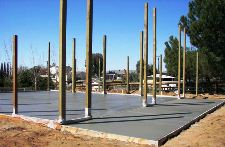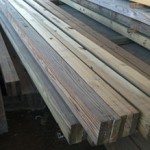Not near as exciting as 867-5309, but this one Section of the International Building Code (IBC) is one of the most important and least understood sections.
The American Wood Preservers Association (AWPA) addresses in, Section UC4 wood, which is pressure preservative treated for “Ground Contact”. The “UC” is short for “Use Class”.
UC4A is for “General Use”. This is “Wood and wood-based materials used in contact with the ground, fresh water, or other situations favorable to deterioration. Examples are fence posts, deck posts, guardrail posts, structural lumber, timbers and utility posts located in regions of low natural potential for wood decay and insect attack.
 UC4B is for “Heavy Duty”. This is “Wood and wood-based material used in contact with the ground either in severe environments, such as horticultural sites, in climates with a high potential for deterioration, in critically important components such as utility poles, building poles and permanent wood foundations, and wood used in salt water splash zones.”
UC4B is for “Heavy Duty”. This is “Wood and wood-based material used in contact with the ground either in severe environments, such as horticultural sites, in climates with a high potential for deterioration, in critically important components such as utility poles, building poles and permanent wood foundations, and wood used in salt water splash zones.”
Neither of these clearly identifies which degree of pressure treating should be utilized for structural in ground use – to support a post frame (pole) building.
When the first IBC was published in 2000, Section 1805.7.1.2 stated, “Wood poles shall be treated in accordance with AWPA C2 or C4. This language remained the same in the 2003 IBC. The AWPA C2 and C4 standards have been withdrawn, therefore are no longer applicable or referenced standards in later editions of the Code.
In the 2006 IBC, however, things changed. Section 1805.7.1 states, “Wood poles shall be treated in accordance with AWPA U1 for sawn timber posts (Commodity Specification A, Use
Category 4B) “. In the 2009 IBC (and repeated for the 2012 edition), the language remained the same, however the referenced section of the Code is now 1807.3.
What does this mean for the average consumer who is shopping for a new pole barn? Everything!
Visit the local lumberyard, or big box lumber store. Take a walk through the pressure treated lumber department. Every piece of pressure preservative treated lumber has a tag on it. This tag identifies who the pressure treater was, as well as the level of pressure treating. Sadly, most of the pressure treated posts will be treated only to UC-4A….which does NOT meet with the Code requirements for use in pole buildings! It is very likely the lumberyard sales people do not realize this to be the case.
Even more frightening, most Building Officials are unaware of this requirement!
When shopping for a new pole building, ask what level of pressure treatment the pressure treated posts are treated to. If the company being contacted does not know, will not tell, or says they are “treated for structural in ground use” (or similar language), or anything other than UC-4B…run, do not walk away!
In order to have a Code conforming building, and one which will last the lifetime it is designed for – demand a minimum UC-4B pressure treating level for all structural load bearing columns.
 Adhesives used in modern glulams are extremely durable and are considered waterproof. Glulam timbers treated after bonding will accept treatment and resist decay similar to treated sawn timbers of the same species and will perform similarly in service. If the appearance of this product is acceptable to the consumer, it can be used successfully in applications where treated wood is required. Provided the structural requirements of the application are met (meaning – was the right size and grade of pole selected for factors such as wind speed, snow load, etc.), treated glulam timbers can be used in place of treated sawn timbers.
Adhesives used in modern glulams are extremely durable and are considered waterproof. Glulam timbers treated after bonding will accept treatment and resist decay similar to treated sawn timbers of the same species and will perform similarly in service. If the appearance of this product is acceptable to the consumer, it can be used successfully in applications where treated wood is required. Provided the structural requirements of the application are met (meaning – was the right size and grade of pole selected for factors such as wind speed, snow load, etc.), treated glulam timbers can be used in place of treated sawn timbers.





